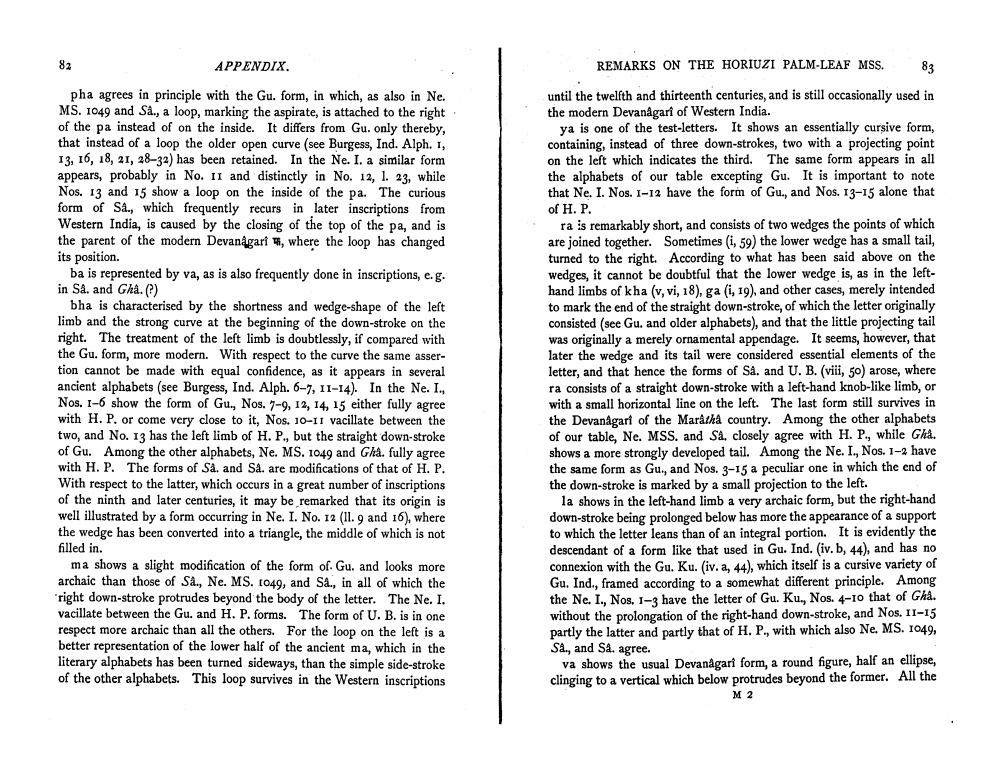________________
APPENDIX
REMARKS ON THE HORIUZI PALM-LEAF MSS.
83
pha agrees in principle with the Gu. form, in which, as also in Ne. MS. 1049 and Sa., a loop, marking the aspirate, is attached to the right of the pa instead of on the inside. It differs from Gu. only thereby, that instead of a loop the older open curve (see Burgess, Ind. Alph. 1, 13, 16, 18, 21, 28-32) has been retained. In the Ne. I. a similar form appears, probably in No. II and distinctly in No. 12, 1. 23, while Nos. 13 and 15 show a loop on the inside of the pa. The curious form of Sa., which frequently recurs in later inscriptions from Western India, is caused by the closing of the top of the pa, and is the parent of the modern Devanagari, where the loop has changed its position.
ba is represented by va, as is also frequently done in inscriptions, e.g. in Sa. and Ghà.)
bha is characterised by the shortness and wedge-shape of the left limb and the strong curve at the beginning of the down-stroke on the right. The treatment of the left limb is doubtlessly, if compared with the Gu. form, more modern. With respect to the curve the same assertion cannot be made with equal confidence, as it appears in several ancient alphabets (see Burgess, Ind. Alph. 6-7, 11-14). In the Ne. I.. Nos. 1-6 show the form of Gu. Nos. 7-9, 12, 14, 15 either fully agree with H. P. or come very close to it, Nos. 10-11 vacillate between the two, and No. 13 has the left limb of H. P., but the straight down-stroke of Gu. Among the other alphabets, Ne. MS. 1049 and Gha. fully agree with H. P. The forms of Sà. and Sa. are modifications of that of H.P. With respect to the latter, which occurs in a great number of inscriptions of the ninth and later centuries, it may be remarked that its origin is well illustrated by a form occurring in Ne. I. No. 12 (11. 9 and 16), where the wedge has been converted into a triangle, the middle of which is not filled in.
ma shows a slight modification of the form of. Gu. and looks more archaic than those of Sa., Ne. MS. 1049, and Sa., in all of which the "right down-stroke protrudes beyond the body of the letter. The Ne. I. vacillate between the Gu. and H. P. forms. The form of U. B. is in one respect more archaic than all the others. For the loop on the left is a better representation of the lower half of the ancient ma, which in the literary alphabets has been turned sideways, than the simple side-stroke of the other alphabets. This loop survives in the Western inscriptions
until the twelfth and thirteenth centuries, and is still occasionally used in the modern Devanagari of Western India.
ya is one of the test-letters. It shows an essentially cursive form, containing, instead of three down-strokes, two with a projecting point on the left which indicates the third. The same form appears in all the alphabets of our table excepting Gu. It is important to note that Ne. I. Nos. 1-12 have the form of Gu., and Nos. 13-15 alone that of H. P.
ra is remarkably short, and consists of two wedges the points of which are joined together. Sometimes (i, 59) the lower wedge has a small tail, turned to the right. According to what has been said above on the wedges, it cannot be doubtful that the lower wedge is, as in the lefthand limbs of kha (v, vi, 18), ga (i, 19), and other cases, merely intended to mark the end of the straight down-stroke, of which the letter originally consisted (see Gu, and older alphabets), and that the little projecting tail was originally a merely ornamental appendage. It seems, however, that later the wedge and its tail were considered essential elements of the letter, and that hence the forms of Sa. and U. B. (viii, 50) arose, where ra consists of a straight down-stroke with a left-hand knob-like limb, or with a small horizontal line on the left. The last form still survives in the Devanagart of the Maratha country. Among the other alphabets of our table, Ne. MSS. and Sa, closely agree with H. P., while Gha. shows a more strongly developed tail. Among the Ne. I., Nos. 1-2 have the same form as Gu., and Nos. 3-15 a peculiar one in which the end of the down-stroke is marked by a small projection to the left.
la shows in the left-hand limb a very archaic form, but the right-hand down-stroke being prolonged below has more the appearance of a support to which the letter leans than of an integral portion. It is evidently the descendant of a form like that used in Gu. Ind. (iv. b, 44), and has no connexion with the Gu. Ku. (iv. a, 44), which itself is a cursive variety of Gu. Ind., framed according to a somewhat different principle. Among the Ne. I., Nos. 1-3 have the letter of Gu. Ku., Nos. 4-10 that of Gha. without the prolongation of the right-hand down-stroke, and Nos. 11-15 partly the latter and partly that of H. P., with which also Ne. MS. 1049, Sa., and Sa. agree.
va shows the usual Devanagari form, a round figure, half an ellipse, clinging to a vertical which below protrudes beyond the former. All the
M2




